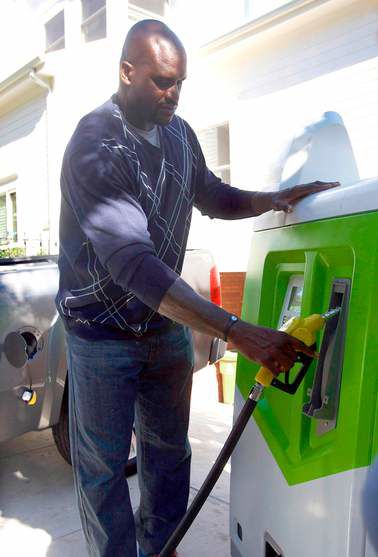Who needs gasoline if youve got old beer?
Published 5:00 am Friday, August 28, 2009

- Basketball star Shaquille ONeal, shown with a MicroFueler, has invested in the systems distributor. The MicroFueler makes ethanol out of organic waste in minutes. It can be installed at individual homes. If we give everybody the ability to make their own fuel, you break the oil infrastructure, says inventor Tom Quinn.
It sounds wonderful: A residential system that allows people to make fuel from old beer, leftover wine and other waste products and use it to run their vehicles.
Thats what inventors of the E-Fuel MicroFueler claim, and theres support for the idea in government, industry and pop culture. MicroFueler buyers are eligible for a $5,000 tax credit. Former Los Angeles Laker Shaquille ONeal is an investor in the systems distributor.
The $10,000 MicroFueler consists of a 250-gallon tank for organic feedstock, such as waste wine and beer, and a still that converts it to 100 percent ethanol, or E-Fuel.
The still doubles as a fuel pump, which works similarly to those at gas stations. The only waste product is distilled water.
If we give everybody the ability to make their own fuel, you break the oil infrastructure, said MicroFueler inventor Tom Quinn, an entrepreneur from Californias Silicon Valley who also developed the motion-control system for the Nintendo Wii gaming system, a version of which is used in his new microrefinery.
Three years ago, I looked at where the world was going, and energy caught my eye, said Quinn, chief executive of E Fuel Corp. in Los Gatos, Calif. As a world, we had no replacement fuel for gasoline, and that led me to alternative fuels such as ethanol.
But what about ethanol that much-maligned alternative fuel?
The problem with it, Quinn said, was energy inefficiency not only in the carbon cost of growing, harvesting and transporting the corn that was used to make it, but in the distillation process that turned it into fuel. Many environmentalists are critical of corn-based ethanol, saying it is an inefficient fuel that uses valuable cropland and leads to food-price increases.
Although Quinns MicroFueler is most effective with wastes high in alcohol content, ethanol can be made out of any waste lawn clippings, dairy products, old chemicals, cardboard, paper, bruised and discarded apples from the grocery store. It can be fermented and turned into fuel in minutes, Quinn said.
If the MicroFueler can save the world, it wont just yet, though. So far, only one MicroFueler is up and running. It was installed in late June at the home of Chris Ursitti, CEO of the GreenHouse, the San Diego company that is distributing the units and supplying feedstock to those who install MicroFuelers at their homes.
You just open up the hatch and pour in some waste, and it turns it into fuel for the car, said Ursitti, whos been using homemade ethanol to run his flex-fuel-converted Lexus hybrid SUV.
GreenHouse has contracts with a few brewers and Sunny Delight to convert 29,000 tons of their liquid waste using MicroFuelers. A tanker truck picks up the companies waste and delivers it to home-based MicroFuelers, which convert it to ethanol on-site. MicroFueler owners are charged $2 a gallon once they pump out the fuel.
Converting expired beer and other liquid wastes into cellulosic ethanol takes minutes and uses three kilowatt-hours of electricity to produce one gallon of fuel.
In addition to powering vehicles, the fuel could run a 7,000-watt Gridbuster home generator, which produces 23 kilowatt-hours of electricity a gallon, GreenHouse says.
Factoring in the $5,000 federal tax credit, an annual household fuel consumption of 2,080 gallons and a $2 charge a gallon, GreenHouse estimates the average consumer payback time is about two years.
Although ethanol has less fuel value than gasoline meaning a car will travel fewer miles on a gallon of ethanol than on a gallon of gasoline it creates 38 percent less carbon dioxide than gasoline when burned.
Although the Environmental Protection Agency has not been called upon to analyze the environmental impacts of (organic ethanol) in comparison to gasoline, EPA spokeswoman Cathy Milbourn said, using waste products derived from renewable sources instead of nonrenewable inputs would likely lead to an overall smaller carbon footprint in comparison to a food-based feedstock, such as corn.
Its legal to make up to 10,000 gallons of alcohol fuel, such as ethanol, each year on ones own property as long as it isnt sold to others. A permit from the U.S. Alcohol and Tobacco Tax and Trade Bureau is required.






